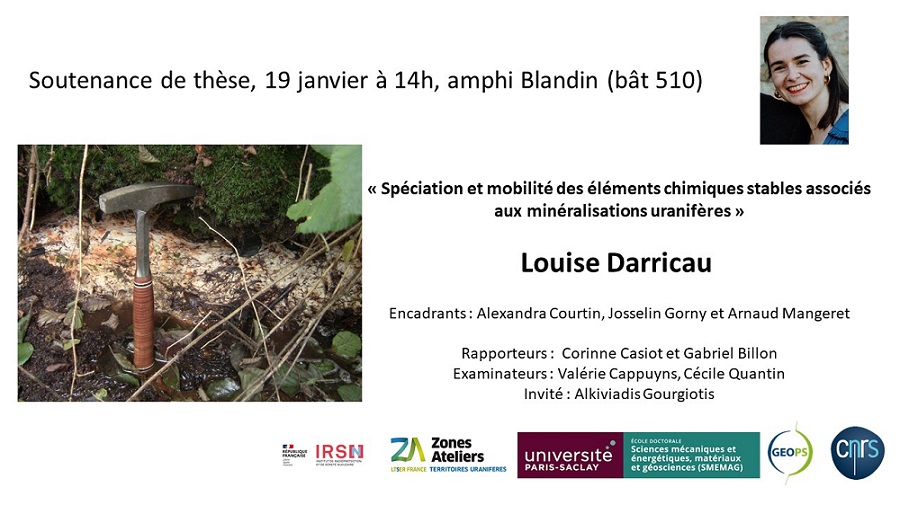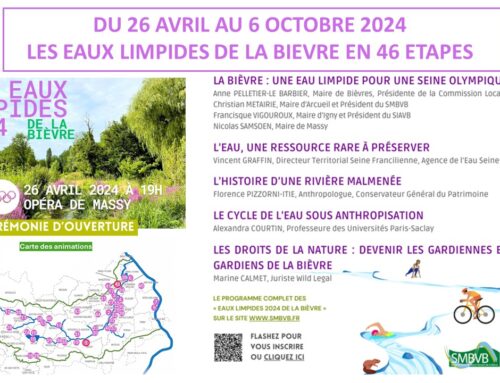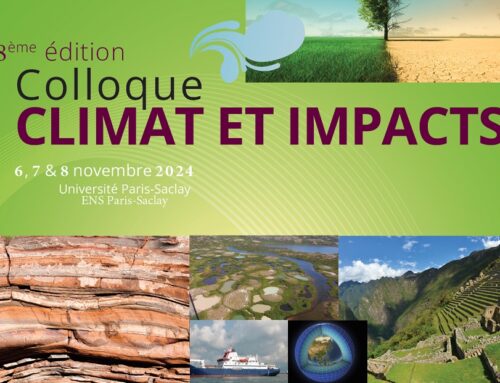Speciation and mobility of stable chemical elements associated to uranium mineralizations
This defense will take place on Friday, January 19, 2024 at 2:00 pm.
Address : Bat. 510, rue André Rivière, 91400 Orsay – salle Amphithéâtre Blandin
Summary of thesis :
From 1948 to 2001, the French uranium (U) deposits were exploited to ensure self-sufficiency for the development of civil and military nuclear activities. Uranium deposits often contain a mixture of primary and secondary minerals, as well as other trace chemical elements (TE), which can be toxic. Even though uranium ore mining and processing has stopped in France, the environments near mine sites may still be affected, resulting in radionuclide contamination that exceeds natural geochemical background levels. The objective of this thesis was to understand the importance of the presence of stable chemical contaminants, in addition to the U, in these environments, in order to improve their management.
U was studied jointly with the TE on two study sites: the first site was the artificial reservoir of Saint-Clément, located in Allier (Auvergne-Rhône-Alpes), whose sediments were influenced by the former U des Bois-Noirs-Limouzat mine and the former Charrier copper-tin mine. The second site was a wetland located downstream of the former U ore extraction and processing sites at Rophin, also in Auvergne-Rhône-Alpes. Different analytical approaches including scanning electron microscopy (SEM), energy dispersive electron microprobe (EPMA), x-ray spectroscopy (XAS), x-ray microdiffraction (µ-XRD), leaching protocol (TCLP, NFEN 12457-2) and parallel and sequential extractions (BCR) were deployed to study TE and U speciation in reoxidized sediment and soil samples, and to identify geochemical processes governing their mobility in these conditions.
For the Saint-Clément site, the results reveal a significant enrichment of copper (Cu), tin (Sn) and bismuth (Bi) in the lake sediments, linked to the former extraction activities of Charrier. Reoxidation and drying of the initially anoxic sediments led to solid metallic speciation dominated by i) inherited Cu and Bi sulfide minerals such as chalcopyrite (CuFeS2), ii) metals associated with natural organic matter (OM) and iii) grains of refractory cassiterite (SnO2). Additionally, TCLP results indicated limited remobilization of metals, thus confirming the stability of U, Cu, and Bi associated with natural OM. For the Rophin site, the results show anthropogenic contributions of U, lead (Pb) and Cu to the soils of the wetland. The highest levels of contamination are linked to a whitish layer inherited from old uranium mining activities. Along a hydromorphic soil profile, solid Pb speciation appears mainly linked to stable phosphates (plumbogummite – PbAl3(PO4)(PO3OH)(OH)6). In old and recent layers rich in OM, sorption processes on it mainly govern the speciation of TEs. In the whitish deposition, the solid speciation of U, Cu and Pb appears to be influenced by adsorption on the particle surface and, to a lesser extent, by the precipitation of authigenic phases and/or the deposition of inherited phases (e.g., U oxides, chalcopyrite, plumbogummite, anglesite – PbSO4, hokutolite – (Ba,Pb)SO4). The NFEN 12457-2 test and the BCR protocol revealed a certain mobility of contaminants (such as Cu and U) which could have an impact on the environment. Ultimately, all of these results highlight contrasting reactivities of the very varied carrier phases in TE under oxidizing conditions.
This thesis highlighted the importance of considering the behavior of contaminants, particularly under oxidizing conditions, as well as all sources of contaminants in future projects to manage contaminated environments.


